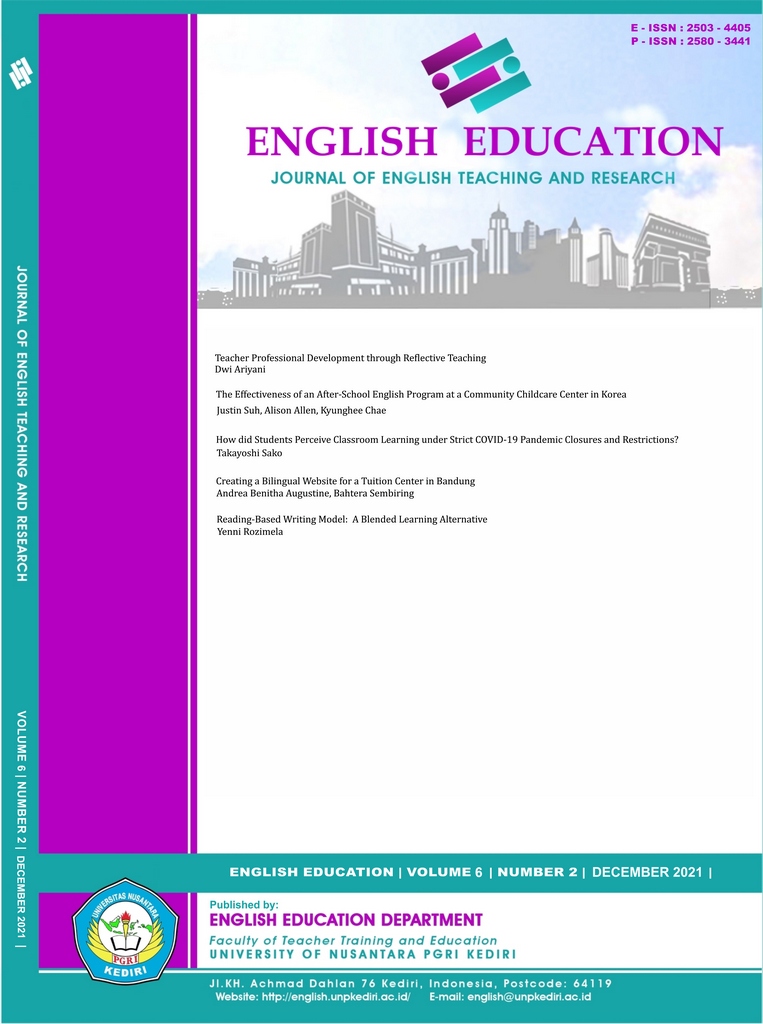How Did Students Perceive Classroom Learning under Strict COVID-19 Pandemic Closures and Restrictions?
DOI:
https://doi.org/10.29407/jetar.v6i2.16394Keywords:
action research, collaborative learning, covid-19 pandemic, school closure, sense of communityAbstract
The COVID-19 pandemic of 2020 required strict infection prevention measures worldwide, including school closure. After school reopened, we implemented Japan’s strict COVID measures, under which close contact in pairs or groups, as well as vocalizing in unison, was proscribed, with students having to remain quiet and face the blackboard.
This study’s aim is to answer the question of how students felt about learning under such extreme constraints. One of the most noticeable findings from the responses to the survey of the 2020 class was that they felt the lack of collaborative learning experiences; hence, in 2021, we implemented changes that would allow for more collaboration while still adhering to COVID prevention guidelines. Among the various collaborative learning activities in the classroom, students reported that they found value in debate activities that challenged their English language skills and critical thinking. Overall, however, students found comfort and value in a semblance of learning with their peers.
It was concluded that even in a volatile and uncertain situation, such as a pandemic, it is crucial to improve environments for collaborative learning. In the future, quantitative study of the impact of collaborative learning on students’ English proficiency will be a useful follow-up study.
Downloads
References
Avci, H., & Adiguzel, T. (2017). A case study on mobile-blended collaborative learning in an English as a foreign language (EFL) context. International Review of Research in Open and Distributed Learning, 18(7). https://doi.org/10.19173/irrodl.v18i7.3261
Brindley, J. E., Blaschke, L. M., & Walti, C. (2009). Creating effective collaborative learning groups in an online environment. International Review of Research in Open and Distributed Learning, 10(3). https://doi.org/10.19173/irrodl.v10i3.675
Burns, A. (2005). Action research: An evolving paradigm? Language Teaching, 38(2), 57–74. https://doi.org/10.1017/S0261444805002661
Burns, A. (2009). Action research. In Qualitative research in applied linguistics Palgrave p. 112–-134. Macmillan.
Chiong, R., & Jovanovic, J. (2012). Collaborative learning in online study groups: An evolutionary game theory perspective. Journal of Information Technology Education: Research. Informing Science Institute. Retrieved February 9, 2021. https://www.learntechlib.org/p/111494/, 11(1), 081–101. https://doi.org/10.28945/1574
Dhawan, S. (2020). Online learning: A panacea in the time of COVID-19 crisis. Journal of Educational Technology Systems, 49(1), 5–22.
Faize, F. & Muhammad, N. (2020). Evaluation and Improvement of Students' Satisfaction in Online Learning during COVID-19. Open Praxis, 12(4), 495–507
Ghavifekr, S. (2020). Collaborative learning: A key to enhance students’ social interaction skills. Malaysian Online Journal of Educational Sciences, 8(4), 9–21.
Higuchi, K. (2014). Quantitative text analysis for social research: Toward the succession and development of Content Analysis. Nakanishiya Publishing, Co.
Kanaya, Yoshihiro. (2014). The Logic of the Knife and the Spear: A Study of the Dialectical Identity of the Universal, the Particular, and the Individual. Bulletin of the Faculty of Education and Culture, Miyazaki University. Social Science, 30, 37-52. http://hdl.handle.net/10458/4820
Miura, T., Nakashima, Y., & Hiroyama, S. (2002). So, so English is education: An approach to English teaching that nurtures the heart, Kenkyusha.
Muuro, M. E., Wagacha, W. P., Kihoro, J., & Oboko, R. (2014). Students’ perceived challenges in an online collaborative learning environment: A case of higher learning institutions in Nairobi, Kenya. International Review of Research in Open and Distributed Learning, 15(6). https://doi.org/10.19173/irrodl.v15i6.1768
Myung, J., & Kimner, H. (2020). Continuous improvement in schools in the COVID-19 context: A summary brief policy analysis for California education. PACE.
Pang, C., Lau, J., Seah, C. P., Cheong, L., & Low, A. (2018). Socially challenged collaborative learning of secondary school students in Singapore. Education Sciences, 8(1), 24. https://doi.org/10.3390/educsci8010024
Pattanpichet, F. (2011). The effects of using collaborative learning to enhance students English speaking achievement. Journal of College Teaching and Learning (TLC), 8(11), 1–10. https://doi.org/10.19030/tlc.v8i11.6502
Saqr, M., Fors, U., & Tedre, M. (2018). How the study of online collaborative learning can guide teachers and predict students’ performance in a medical course. BMC Medical Education, 18(1), 24. https://doi.org/10.1186/s12909-018-1126-1
Singh, V., & Thurman, A. (2019). How many ways can we define online learning? A systematic literature review of definitions of online learning (1988−−2018). American Journal of Distance Education, 33(4), 289–306. https://doi.org/10.1080/08923647.2019.1663082
Stacey, E. (1999). Collaborative learning in an online environment. Distance Education, 14(2), 14–33.
Wentzel, K. R., & Watkins, D. E. (2002). Peer relationships and collaborative learning as contexts for academic enablers. School Psychology Review, 31(3), 366–-377.
Yaacob, A., & Asraf, M. (2021). Empowering learners’ reflective thinking through collaborative reflective learning. International Journal of Instruction, 14(1), 709–726.
Downloads
Published
Issue
Section
License
Authors who publish with this journal agree to the following terms:
- Copyright on any article is retained by the author(s).
- The author grants the journal, the right of first publication with the work simultaneously licensed under a Creative Commons Attribution License that allows others to share the work with an acknowledgment of the work’s authorship and initial publication in this journal.
- Authors are able to enter into separate, additional contractual arrangements for the non-exclusive distribution of the journal’s published version of the work (e.g., post it to an institutional repository or publish it in a book), with an acknowledgment of its initial publication in this journal.
- Authors are permitted and encouraged to post their work online (e.g., in institutional repositories or on their website) prior to and during the submission process, as it can lead to productive exchanges, as well as earlier and greater citation of published work.
- The article and any associated published material is distributed under the Creative Commons Attribution-ShareAlike 4.0 International License








 Article template
Article template



